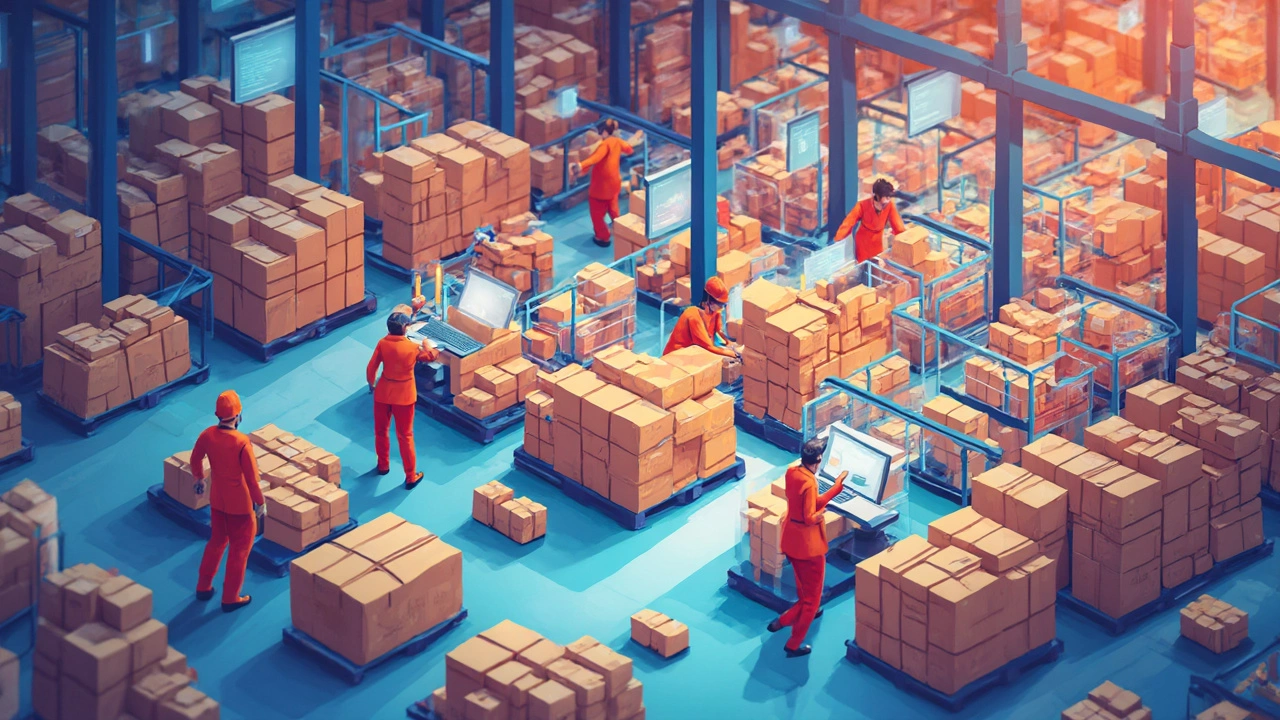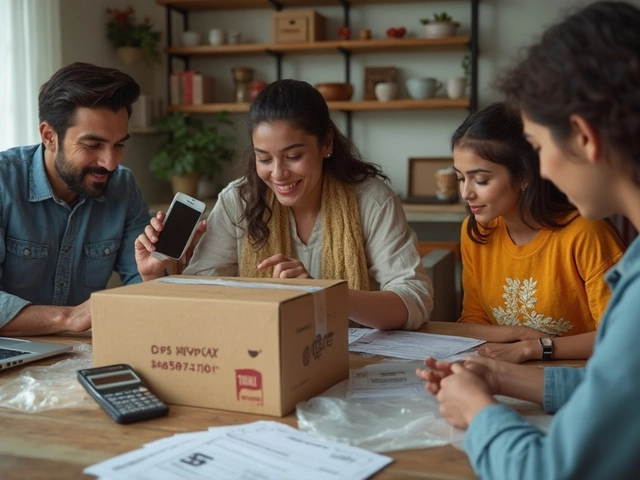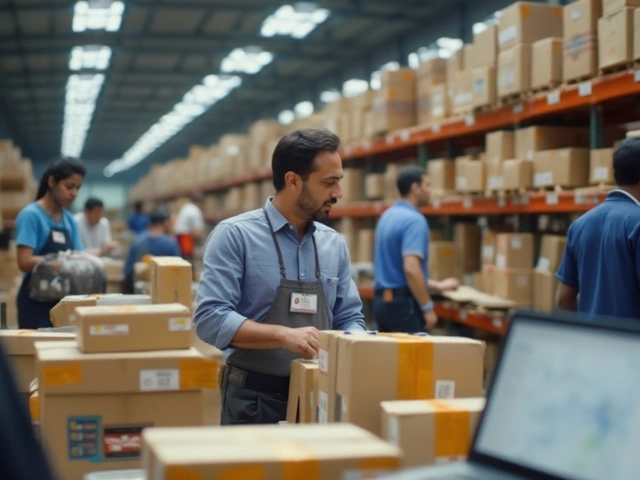E-logistics is the unsung hero behind every successful online purchase you make. But have you ever wondered how that perfect sweater gets from the online store to your doorstep so quick? Buckle up, because it’s all about the magic of e-logistics, which coordinates the flow of goods and information seamlessly.
It starts with order management. Once you click 'buy,' a sophisticated system kicks into gear, checking inventory in real-time to make sure what you want is available. If it is, the warehouse team preps your item for shipment. This efficiency means shorter wait times and fewer mix-ups, making sure customers stay happy and loyal.
- E-Logistics: The Backbone of E-Commerce
- Order Management and Inventory Tracking
- Tech Innovations Transforming Logistics
- Challenges in E-Logistics
- The Role of Last-Mile Delivery
- Future Trends in E-Logistics
E-Logistics: The Backbone of E-Commerce
Picture this: You're scrolling through your favorite online store, and within a few clicks, that must-have gadget is on its way to your home. How does it happen so smoothly? That's where e-logistics steps in, working tirelessly behind the scenes. It's the beating heart of the e-commerce world, making sure everything runs without a hitch.
At its core, e-logistics is all about efficiency and speed. These systems manage everything from supply chain coordination to last-mile delivery. It's about ensuring that every step, from order placement to shipping, goes off without a hitch.
Seamless Order Management
When you place an order, an advanced order management system immediately swings into action. It checks stock levels and ensures the item is ready to ship. Companies employ sophisticated algorithms to predict demand, reducing the risk of stockouts or overstock situations.
Efficient Inventory Tracking
Inventory tracking is a big deal in e-logistics. Imagine having a global warehouse network and knowing at every moment how much stock is available and where. Technologies like barcode scanning and RFID chips make this a reality, allowing for real-time insights.
Streamlining the Process
Efficiency is the name of the game in e-logistics. By optimizing routes and choosing the best carriers, companies can minimize delivery times and costs. This not only saves money but also boosts customer satisfaction.
- E-commerce platforms often use GPS tracking to monitor shipments in real time.
- Customer communication is crucial—providing updates and tracking info keeps buyers in the loop.
- Returns are handled efficiently, thanks to streamlined reverse logistics processes.
Now, here’s a cool fact to illustrate the impact of e-logistics: According to a report from 2023, the e-commerce logistics market is expected to hit $1 trillion by 2027. That’s massive growth highlighting just how pivotal e-logistics is to modern commerce.
Order Management and Inventory Tracking
Imagine you just placed an order online. What happens next might surprise you! This is where order management and inventory tracking play a crucial role in e-logistics. It's like an orchestral performance where each instrument knows exactly when to play.
First things first, the order management system steps in. It not only logs your purchase but automatically checks available stock. This ensures the store doesn’t bite off more than it can chew. For online retailers, this system saves time, reduces errors, and ensures happy customers.
How Inventory Tracking Works
The inventory tracking system ensures that each product’s journey is smooth. By monitoring stock levels in real-time, it helps avoid dreaded out-of-stock messages. RFID tags, barcodes, and IoT devices are some of the tools that keep everything in line.
Did you know that efficient inventory management can cut inventory costs by up to 30%? This means more savings, which hopefully benefit the shopper too.
Benefits of Integrated Order and Inventory Systems
- Seamless fulfillment: Perfect order management translates to efficient shipment.
- Reduced errors: Less mix-up means fewer returns and refunds.
- Customer satisfaction: Fast deliveries boost customer loyalty.
Pioneers like Amazon have mastered this art. Real-time tracking not only helps them know what’s on hand but also predicts future sales trends, thanks to data analytics. As that perfect sweater moves from warehouse to delivery truck, it’s only because the e-logistics system knows precisely what’s available and where it needs to go.
For e-commerce businesses, staying on top of order management and inventory tracking isn't just a good idea; it's essential. So next time you shop online, remember there’s a whole digital symphony working hard behind the scenes to get your package to your doorstep!
Tech Innovations Transforming Logistics
In the realm of e-commerce logistics, technology is the MVP, bridging gaps and speeding up processes like never before. From drones to blockchain, let's see what's shaking up the scene.
AI & Machine Learning
AI is like a multitasking dynamo in e-logistics. It's predicting what you'll want to buy next and ensuring warehouses are ready. AI tools can analyze past shopping patterns, optimizing inventory so shelves are always stocked with the right items. Plus, they're reducing shipping costs by figuring out the best shipping routes and methods in real time.
Internet of Things (IoT)
With IoT, every package, truck, or shipment is a walking (or rolling) database. Sensors keep a constant eye on important data like temperature and humidity for sensitive goods. They also track assets, reducing losses and ensuring better security. This kind of transparency means if your parcel goes off course, the system knows—and fixes it ASAP.
Blockchain
When it comes to security and trust, blockchain is the tech equivalent of a safety deposit box. It creates a tamper-proof record of transactions and steps in the supply chain. So, buying high-value goods? Customers and companies can verify its authenticity and journey, which is super important for maintaining trust in any online shopping platform.
Drones and Robotics
Drones are starting to lift logistics to new heights—literally. They're being tested and used for delivering packages quickly, especially when roads are jammed. Inside warehouses, robots work alongside humans, handling sorting, packing, and even some deliveries to help speed up the process. Imagine next-day delivery becoming a standard because robots don't need lunch breaks!
Big Data Analysis
With so much data flying around, making sense of it all is a must. Big Data's role in e-logistics is all about deriving actionable insights from a tidal wave of info. It's like having a crystal ball that helps forecast demand, plan inventory, and ultimately provide customers with a fast, smooth shopping experience.

Challenges in E-Logistics
Even with all the tech advancements, there are still bumps in the road for e-logistics. One biggie? Tackling delivery delays. Whether it's bad weather, traffic jams, or issues at customs, these hiccups can turn a planned smooth delivery into a nail-biting experience for customers.
Inventory Management
Keeping track of stock is like juggling knives—seriously tricky. Companies sometimes struggle with having either too much inventory, which ties up money, or too little, causing missed sales opportunities. It's a delicate balance, and if not managed well, it can hit the bottom line hard.
Last-Mile Delivery
The infamous last-mile delivery is a riddle for many. Getting goods from warehouse to the customer's front step quickly, without skyrocketing costs, is complex. Urban areas face traffic congestion, while remote locations can lead to higher delivery costs.
Cost Management
Operating e-logistics isn’t cheap. Companies must juggle maintaining infrastructure while keeping operational costs down, which can be a tightrope walk. There's always a desire to offer free shipping to customers, but it must be balanced with the realities of business expenses.
Technology Integration
Incorporating new tech solutions while ensuring they mesh well with existing systems is another tricky task. It requires investment, time, and skilled personnel to avoid disruptions. Many businesses face challenges when deploying AI, IoT, or blockchain into their logistics processes.
| Challenge | Impact |
|---|---|
| Delivery Delays | Customer dissatisfaction |
| Inventory Mismanagement | Lost sales or excess costs |
| High Last-Mile Delivery Costs | Increased overhead |
| Tech Integration Issues | Operational disruptions |
Despite these tricky scenarios, e-logistics is full of potential, especially when companies find innovative strategies to tackle these issues. The key is staying agile and ready to adapt to whatever comes next.
The Role of Last-Mile Delivery
Last-mile delivery might sound like something out of a marathon, but it’s actually the final step in getting a package from a distribution center to the customer’s doorstep. It’s where the rubber hits the road in e-logistics and a crucial factor in customer satisfaction.
The trickiest part? Navigating urban jungles, suburban mazes, and even rural outposts. Deliveries can get delayed by traffic jams, wrong addresses, or just plain old bad weather. This makes last-mile delivery a make-or-break moment for e-commerce businesses determined to wow their customers.
Innovations Making a Difference
Luckily, tech is stepping up in a big way. Companies are investing in everything from smart lockers at popular spots to drones buzzing between rooftops, all to shorten delivery times. And let’s not forget AI-driven route optimization, which makes sure delivery drivers spend less time stuck at red lights and more time knocking on your door.
Even old-school methods like local delivery hubs are getting a modern makeover. Instead of schlepping goods across town, packages get sorted at smaller centers closer to customers, cutting down on fuel and time.
The Challenge of Costs
Here’s a head-scratcher: last-mile delivery accounts for over 50% of total shipping costs. Yeah, you read that right. Fuel, labor, and vehicle maintenance all add up. So, while e-commerce giants invest in greener vehicles and delivery robots, any penny saved could mean another smile for their bottom line.
| Aspect | Percentage |
|---|---|
| Shipping Costs | 50% |
| Customer Satisfaction Impact | 60% |
But there’s a bright side. Smart last-mile solutions help businesses keep pace with customer expectations and keep their environmental impact in check. It’s not just about dropping off a package, but about crafting a seamless e-commerce logistics experience that keeps customers coming back for more.
Future Trends in E-Logistics
The world of e-logistics is constantly evolving, and staying ahead of the curve means adapting to some cool new trends. It's like a sneak peek into the future of online shopping!
Artificial Intelligence (AI) Takes Over
AI isn't just a buzzword; it's transforming how e-commerce logistics works. Picture this: smart algorithms predicting demand, optimizing delivery routes, and managing inventory, all in real-time. It's like having a brainy assistant guiding every decision.
The Internet of Things (IoT) Revolution
With IoT, we’re talking about smart warehouses and connected devices everywhere. Sensors track products from the moment they leave the shelf to when they're delivered to the customer. This means fewer hiccups and happier customers.
Blockchain Brings Transparency
Blockchain isn't just for cryptocurrencies anymore. It’s entering the e-logistics world to add a layer of security and transparency. By keeping an unchangeable record of transactions, everyone in the supply chain stays honest and informed.
Environmental Sustainability
Consumers are more eco-conscious, and so is the logistics world. Expect to see more electric delivery vans, eco-friendly packaging, and efforts to consolidate shipments to cut down on carbon footprints.
| Year | Predicted E-Logistics Market Growth |
|---|---|
| 2025 | 10% |
| 2030 | 15% |
Drones and Autonomous Vehicles
Delivery by drones and self-driving cars might sound sci-fi, but they're rolling out sooner than you think. These innovations promise to speed up delivery times and reduce costs.
So, what does all of this mean for businesses and consumers? Well, a more efficient, transparent, and eco-friendly logistics system ultimately benefits everyone, ensuring quicker delivery times, reduced costs, and happier customers. Keeping an eye on these trends is crucial for businesses to thrive in the competitive e-commerce landscape.





